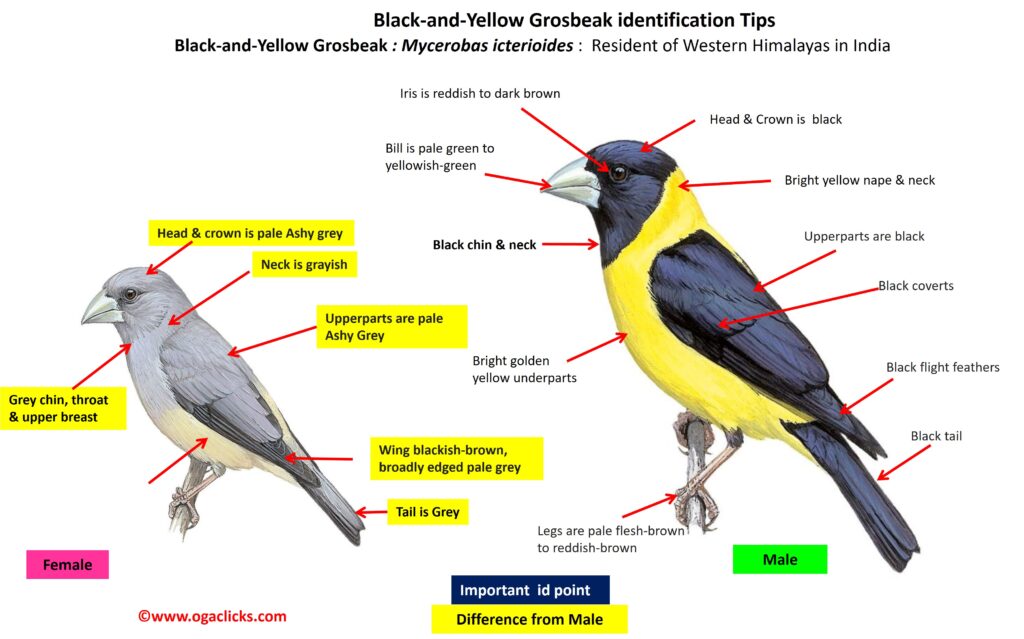
Black-and-Yellow Grosbeak Mycerobas icterioides
Etymology:
- Emberiza : Old German name Embritz for a bunting
- Spodocephala: spodos ashes; kephalos -headed. { Ashy headed}
Vernacular name : Kash: Wyet tont
Distribution in India: Resident of West Himalayas .
Description: It has a size of 22 cm; 67 g. it is a large grosbeak with large head, massive bill and medium-length and notched tail. The Male has entire head down to upper nape, upper side of neck and lower throat as black. The nape to lower rump, lower side of neck and underparts are bright golden-yellow. The side of mantle, scapulars, wing, uppertail-coverts and tail are black. The iris is reddish to dark brown; bill is pale green to yellowish-green. The legs are pale flesh-brown to reddish-brown. The female has head to upper breast and upperparts pale ashy grey, tinged slightly buffish on mantle and scapulars. The lower back and rump are pale tawny or light buff-brown with pale grey feather bases, uppertail-coverts are pale grey. The central tail feathers are greyish, outer feathers are black; median and greater upperwing-coverts are ash-grey, broadly fringed pale grey. Rest of wings are blackish-brown, broadly edged pale grey on secondaries and tertials. The lower breast and underparts are fawn-buff; bill is pale green or greyish-green. The juvenile is like female; first-winter and first-summer males have blackish feather tips on head, black wing and tail, blackish-mottled mantle and back, yellow rump and greyish-yellow throat to breast. It acquires adult plumage in second winter, bill as on adult female or more horn-coloured..
Habitat: It is found in montane and submontane moist conifer and deodar forest. It is found mostly at 1800–3350 m. In non-breeding season it is found in similar habitat or more open woodlands at lower levels.
Food habits: It eats seeds, buds, shoots and berries . It occasionally eats insects and larval moths and cicadas, snails and slugs. The nestlings are fed mostly with small insects and larvae. It forages on the ground in bushes and low trees, and in canopy of tall trees, usually concealed in foliage. In non-breeding season often digs into exposed areas of ground beneath trees and bushes. It is shy and retiring, but occasionally tame and approachable, and usually detected by ringing calls. It is found in pairs and in loosely scattered flocks; in non-breeding season occurs in small groups, often larger numbers at communal roosts.
Breeding habits: They breed in May to early Sept; two broods. The display done by male with body horizontal and wings spread, quivering or fluttering rapidly, perches alongside female and offers her berries from his bill; mating follows. The nest is built by both sexes, majority by female ; male presenting nesting material to female as part of pair-bonding process. The nest is a large, shallow cup of plant stems, roots and fibres, dried grass, bark strips, pine needles, moss and lichens, on platform of fir twigs, placed above ground and well concealed by overhanging foliage close to trunk of tree. They lay a clutch of 2–3 eggs. The incubation is done by female. The incubation period is 14–15 days. The chicks are fed by both parents